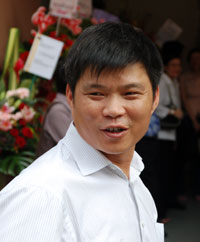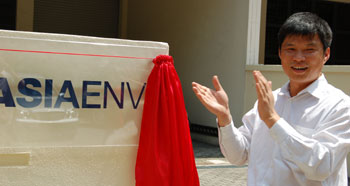 Asia Environment's equipment sales increased about 19% in 1H07.
Asia Environment's equipment sales increased about 19% in 1H07.
ASIA ENVIRONMENT, a leading Chinese designer, builder and operator of water treatment plants, upped its 1H07 revenues by 7% to Rmb 150.8 million.
Equipment sales increased Rmb 3.62 million, about 19%.
Turnkey services for BOT projects increased sales Rmb 5.5 million, about 5%.
Construction of BOT projects at Suzhou Fenhu, Shanghai Jingshan, Jiangxi Jingdezhen and Hunan Wangcheng started during the period.
Four more BOT projects will be completed over the next six months.
Asia Environment’s projects span the length and breath of China - Jiangxi and Hunan in the south, Jiangsu’s coastal cities and Shanghai in the east, and Heilongjiang’s capital, Harbin, in the northeast.
There are jobs aplenty in China's booming water treatment industry for Asia Environment, which was founded in 1984 by an engineer, Wang Hongchun, in Yixing near Lake Tai, China's third largest lake.
Wang, the 43-year-old CEO, has received accolades from Chinese authorities for his contribution to irrigation technology.
Design and production of filtration systems and other water treatment equipment have always been Asia Environment’s core expertise. The popular ‘Penyao’ industrial filters are designed, produced and sold by the company.
It has moved up the value chain, taking on turnkey contracts, and in recent years, building and operating water supply and sewage treatment plants (BOT, BOO and TOT plants).
Construction of its first BOT wastewater treatment plant was completed in Nanchang in 2006. Plant building and operation contributed 70% of group turnover in FY2006. China's water sector will boom over the next decade as it brings its water infrastructure nationwide to First World levels, says Asia Environment CEO Wang Hongchun.Asia Environment is exposed to China’s water supply and sewage treatment industry which will boom until infrastructure for water amenities reaches First World standards in about a decade, says Wang.
China's water sector will boom over the next decade as it brings its water infrastructure nationwide to First World levels, says Asia Environment CEO Wang Hongchun.Asia Environment is exposed to China’s water supply and sewage treatment industry which will boom until infrastructure for water amenities reaches First World standards in about a decade, says Wang.
The next decade will see sustained municipal demand for water infrastructure, he says.Chinese authorities are placing greater attention on water supply and sewage treatment.
For example, when a massive algae outbreak in Lake Tai June this year cut off for days tap water supply for 2.3 million residents of Wuxi, a thriving Jiangsu industrial city, authorities immediately implemented a myriad of measures the following month.
These measures, which include limits on microbe content, organic matter and disinfectants, augur well for Asia Environment with its technical edge in filtration systems.
Rising contract values
Currently, China can only treat 30% of organic substances in water drawn from natural sources, according to China’s Disease Prevention and Control Center.
The remaining 70% of organic substances in most water works systems emerge from the taps of consumers. To make matters worse, more than 70% of China's rivers and lakes are polluted and more than 50% of its urban groundwater contaminated.
Municipals, which form the bulk of Asia Environment’s business, are likely to up contract values for more demanding project requirements, figures Wang.
Higher tariffs, larger plants, more projects
Pollution incidents such as the massive algae outbreak in Lake Tai last month have prompted China’s Ministry of Health to roll out a nationwide effort to inspect water quality. Under pressure from the central government, municipalities are speeding up the development of local water infrastructure by raising tariffs payable to BOT plant operators.
Water prices in cities may continue to rise 50% to 100% over the next five years, according to Ministry of Construction’s Vice Minister Qiu Baoxing. Qiu’s comment on government measures to curb the squandering of scarce water resources was reported in November 2006 by Xinhua news agency.
Nationwide, the cost of residential water use has already risen 42% from 2000 to 2005, according to a survey of 36 cities by China’s National Bureau of Statistics.
Water tariffs across China have been on a steady uptrend. Beijing, with its severe water shortage, has raised water tariffs nine times in 15 years to RMB 3.70 per cubic meter currently. It has the priciest water in China, more than 30 times the RMB 0.12 it charged in 1991.
Nanchang’s municipality, which gave Asia Environment its first contract for a BOT wastewater treatment plant, announced in mid-July this year its intention to more than double current water tariffs. Its tariffs for treatment of municipal wastewater are set to hike 163% to RMB 0.58 per cubic meter, up from RMB 0.22.
Wang expects to start collecting wastewater treatment tariffs from the Nanchang municipal come November this year.
In the BOT construction segment, as more players jump onto the bandwagon, would margins of Asia Environment’s BOT construction segment be affected?
“We are the market leader among local players and have a good track record,” says Wang. International players like Veolia and Suez tender at higher bids.
China needs larger plants
China's second reason for upping tariffs is its need to fund more and larger water treatment plants to cater for a sharp population growth.
City planners commission water infrastructure with its huge investment cost to last at least half a generation. The concession period granted to the likes of Asia Environment for operating BOT plants is at least 20 years.
Nanchang’s mega 200,000 ton-per-day BOT plant was planned for a population of six million, which it expects to reach by 2020. This is a third more than its population of 4.5 million as at end 2006.
Asia Environment is among a handful of Chinese companies licensed to design and build mega-scale water infrastructure. Wang notes the attractive economies of scale enjoyed by large projects.
One trillion yuan has been earmarked by China’s Ministry of Construction for building wastewater treatment plants and upgrading water distribution infrastructure in China by 2010. A third of this budget is for some 278 cities where there are no proper wastewater treatment facilities.
“Demand for new projects will always be there,” says Wang, who sees the industry growing until infrastructure for water amenities reaches First World standards.
 Asia Environment has established itself as a BOT water infrastructure investor, builder and operator
Asia Environment has established itself as a BOT water infrastructure investor, builder and operator
Asia Env's new status as established BOT player
There are risks involved in BOT projects, such as the project delays that happened to Asia Environment in 2004 during the construction of its first two BOT projects.
Group revenues fell 16% that year.
The experience has made the company emphasise the securing of pre-requisite legislature approvals and funding partners, and deploying sub-contractors.
Construction work on the company’s Nantong and Pizhou plants are on track for completion by year-end. BOT projects in Jiangxi (Jingdezhen) and Hunan (Wangcheng) are likely to be completed by 1Q08.
Wang estimates that combined water tariffs in excess of RMB 100 million are payable by the Nanchang, Nantong, Pizhou, Jiangxi and Hunan municipalities to the company’s first five BOT plants next year.
Managing for stable revenue
After 2004’s revenue dip due to project delay, Wang is committed to delivering stable revenue. Collecting tariffs from supplying fresh water or treating sewage is one way. Tendering for projects of varying sizes is another.
Typically, a 50,000 ton-per-day facility is scheduled for construction over a year. Asia Environment is able to speed up delivery of larger projects such as Jingdezhen’s 80,000 ton-per-day facility to as short as 5-6 months. Smaller facilities like the one at Wangcheng with half the capacity can be completed in 4 months.
Wang also wants to acquire plants for their immediate water tariff revenue.
 Expanding overseas: CEO Wang Hongchun at the opening ceremony of the company's new Singapore office in Kaki Bukit this month.With a strong track record, the company is more confident than ever of penetrating new geographical markets.
Expanding overseas: CEO Wang Hongchun at the opening ceremony of the company's new Singapore office in Kaki Bukit this month.With a strong track record, the company is more confident than ever of penetrating new geographical markets.
The company’s maiden overseas foray, announced in April 2007, was a US$38 million tender for a turnkey effluent treatment plant in Bangladesh. Joint bidder, Development Construction Ltd, is an established infrastructure contractor in the nation with a population of 150 million.
Even with the lowest bid in the Bangladesh project, Wang expects to see better gross margins than for similar China projects. After all, he is bringing technology to a nation thirsty for solutions to water contamination issues similar to China’s.
Wang enjoys first-mover advantage doing so. With help from the likes of him, Bangladesh now requires its textile and tannery plants to use a central effluent treatment plant instead of disposing effluent into rivers.






